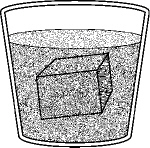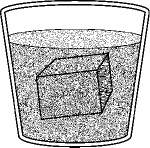Modified True/False
Indicate
whether the statement is true or false. If false, change the identified word or phrase to make
the statement true.
|
|
|
1.
|
When the buoyant force on a ball is less than the weight of the ball, the ball
will float. _________________________
|
|
|
2.
|
Heat is created as fluid surrounds an object.
_________________________
|
|
|
3.
|
Buoyancy states that less dense objects will float in more dense fluids.
_________________________
|
Multiple Choice
Identify the
choice that best completes the statement or answers the question.
|
|
|
4.
|
The lifting force that causes an object to float is known as:
a. | density. | b. | buoyancy. | c. | volume. | d. | fluidity. |
|
|
|
5.
|
If an object is less dense than the fluid it is placed in, it will:
a. | sink. | b. | float. | c. | drift in the middle
of the fluid. | d. | dissolve in the fluid. |
|
|
|
6.
|
Warm air rises above cool air because:
a. | warm air is less dense than cool air. | b. | warm air is more dense than cool
air. | c. | warm air has the same density as cool air. | d. | warm air has more
weight than cool air. |
|
|
|
7.
|
If a low-density object is placed in a high-density fluid, the object
will:
a. | float. | b. | sink. | c. | increase in
density. | d. | decrease in density. |
|
|
|
8.
|
Archimedes’ principle states that the buoyancy force is equal to:
a. | the weight of the fluid displaced by an object. | b. | the mass of the
object divided by its volume. | c. | the mass of the object. | d. | the volume of the
object. |
|
|
|
9.
|
If an object with a density of 2.0 g/cm3 is placed in a fluid with a
density of 1.9 g/cm3, the object will:
a. | float. | b. | sink. | c. | have neutral
buoyancy. | d. | dissolve in the fluid. |
|
|
|
10.
|
An object that weighs 50 newtons in air weighs only 35 newtons when submerged in
water. What is the buoyant force exerted by the water on the object?
|
|
|
11.
|
The air near the ceiling of a classroom has a temperature of 30°C while the
air near the floor has a temperature of 27°C. What conclusion can you make about the air in the
room?
a. | The air near the ceiling is more buoyant than the air near the
floor. | b. | The air near the ceiling is less buoyant than the air near the
floor. | c. | The air near the ceiling has the same density as the air near the
floor. | d. | The air near the ceiling is more dense than the air near the
floor. |
|
|
|
12.
|
In order to make air float, which of the following must be done?
a. | Its density must be made smaller. | b. | It must be heated. | c. | Its volume must be
increased. | d. | Any of the above |
|
|
|
 Figure
4-1A Figure
4-1A
A 1000 cm 3 block of aluminum has a density of 2.7 g/cm 3. The block
is placed into a tank of water.
|
|
|
13.
|
What volume of water is displaced by the aluminum block in Figure
4-1A?
a. | 2.7 mL | b. | 100 mL | c. | 1000
mL | d. | 2700 mL |
|
|
|
14.
|
What mass of water is displaced by the aluminum block in Figure
4-1A?
a. | 2.7 g | b. | 100 g | c. | 1000
g | d. | 2700 g |
|
|
|
15.
|
What is the buoyant force exerted on the aluminum block in Figure
4-1A?
a. | 2.7 N | b. | 9.8 N | c. | 100
N | d. | 1000 N |
|
Completion
Complete each
statement.
|
|
|
Select the correct term to complete each sentence. There are extra terms in
the list.| density | buoyancy | volume | | mass | float | solids | | Archimedes’ principle | gases | Newton’s first law | | sink | weight | liquids | | | |
|
|
|
16.
|
If an object is less dense than the fluid it is placed in, it will
____________________.
|
|
|
17.
|
____________________ on an object in a fluid is the upward force equal to the
weight of the fluid displaced by the object.
|
|
|
18.
|
________________________________________ states that the buoyant force is equal
to the weight of the fluid displaced by the object.
|
Short Answer
|
|
|
19.
|
List a floating or sinking example of liquid-in-liquid or gas-in-gas.
|
|
|
20.
|
How does the buoyancy of an object depend on its density? Use the terms
float and sink in your answer.
|
Problem
|
|
|
21.
|
Calculate the volume of a small iceberg with a mass of 200,000
kilograms.
(density of ice = 920 kg/m3)
|
|
|
22.
|
A piece of wood with a volume of 500 cubic centimeters and a mass of 400 grams
is floating in water. What is the weight of the water displaced by the wood?
|
|
|
23.
|
A cube of lead measuring 2 cm on a side is dropped into a beaker of
mercury.
Solid lead has a density of 11.3 g/cm3. Liquid mercury has a density of
13.6 g/cm3.
a. Does the lead sink or float in the mercury?
b. What is mass of
the cube of lead?
|
|
|
24.
|
 A small metal
block with dimensions of 5 cm ´ 5 cm ´ 5 cm is placed into a tub of water and sinks. a. What volume of
water does the metal block displace? b. What mass of water does the metal block
displace? c. What weight of water does the metal block displace? d. What is the
buoyancy force on the metal block?
|
Essay
|
|
|
25.
|
Jim and his friend Bill are building a small pond on their farm by piling rocks
across the channel of a stream to make a dam. If they have difficulty lifting a rock out of the water
to move it to the dam, they carry the rock more easily by keeping it under the surface of the water.
Explain why this works.
|
|
|
26.
|
The density of steel is 7800 kg/m3. The density of water is 1000
kg/m3. Explain how steel ships are made to float in water.
|
|
|
27.
|
The air near the ceiling of a classroom has a temperature of 30ºC while the
air near the floor has a temperature of 25ºC. What conclusions can you make about the
density and buoyancy of the air in the classroom?
|
|
|
28.
|
A ball with a density of 12 g/cm3 is placed in a fluid with a density
of 20 g/cm3. Explain in detail what happens to the ball and why. Be sure to discuss
buoyancy in your answer.
|